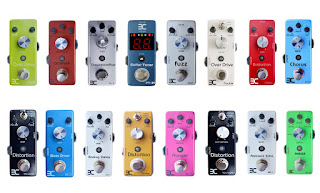DC resistance (DCR) is what we all are most familiar with in pickups. It's the reading used to determine the number of windings in relation with the wire gauge, in resistance. Assuming that the wire gauge is the same, the more the windings, the higher the DCR; the lesser the windings, the lower the DCR. Assuming the windings are the same amount, the thinner the wire gauge, the higher the DCR; the thicker the wire gauge, the lower the DCR. Simple high school physics, right...
Overwinding a pickup, as done in humbuckers from 1959, the 59 PAFs have a stronger midrange and higher output compared to the early 56/57 PAFs.
And in the end, all high DCR means high output, low DCR means low output, correct? Not exactly that simple. Take for example, the Dimarzio D Activator set. They are the some of the highest output pickups from Dimarzio's catalogue, but they are not wound hot at all. A quick run through the spec sheet, shows that the D Act pair has very low DCR. In fact, the neck pickup has a 7.2k reading only, lower than a PAF's standard 7.8k, which resulted in an almost singlecoil-y sound. The bridge pickup has a 11.4k reading, which is moderately overwound. They are very loud and powerful, but not hot-feeling at all. They give a loud, clear, bright sound, and it's unforgivingly responsive. Of all times we hear the term "powerful pickups", more often than not it's the hot, fat, warm (or dark) sound from overwound humbuckers. The D Act set, is the complete opposite of those criteria.
There are of course, many other factors causing them to sound like that. First thing first, they employ ceramic magnets. This is what's pumping out the loud, bright sound from them. Then, there's the hex pole screws, that according to pickup designers, they have a more focused "view" of the strings, and therefore when installed, increases the speed of pick response. Put the windings into context, and we have a set of pickups that imitates the huge sound and response of EMGs, but with a more dynamic sensing of the player's picking hand technique.
Here's the essence of what I've learnt from dissecting the spec sheets of pickups:
- The reason why early/vintage pickups are wound to be very low output, was that they didn't use very strong magnets. Winding them to be hotter takes away the treble and adds more mids. They won't cut as well in clean mode, although they'll still do well in driven sounds. Alnico IIs were used back then to make the 57 PAFs (don't start me on why it wasn't aged A5s, that'll be reserved for another post...) and Alnico Vs had completely replaced them in '59. A2s gave a lower output, with a slow response in the midrange (ahh, the ever-famous spongy, compressed driven sound and endless sustain), so pickups back then were wound to be less hot to keep the sound clear and bright. When A5s were used, they realised that with the original winding, some pickups sounded too harsh in the high end. So, the overwound PAF was born.
- The reason why most cheap pickups sound like crap, was that either they wanted to copy the DCRs of vintage pickups but paired with a ceramic magnet, or that they had overwound some Alnico pickups too much to a point where clarity went down the shitter. Ceramic pickups were meant to be of high DCR, because they're inherently bright and fast. A higher DCR will tame the high end of ceramic pickups, and make them more usable.
- Alnico pickups on the other hand, needed some balanced winding to sound good. Some cheaper Alnico pickups, like Epiphone's Alnico Classic pickups, were wound to be too hot. Sources had said they were equipped with A5, but the muddy sound I get from them seems to support the rumours of them being A2. And overwinding an A2 pickup is just looking for trouble. Plus, the cheaply made nickel-plated brass pickup cover is one hell of a tone blanket.
- Single coils are meant to have a mid-high winding. One vintage single coil measures at 5.7k DCR on average, but cheap ceramic single coils have only 4.5k average. That's the main reason why most ceramic single coils sound wimpy and empty in the mids, but bright and clanky in the highs. Why some single coils like P90s are also in soul, a ceramic single coil, but sounds way better? That's because, apart from the wider "view" of the strings, they're also wound to an average of 7.8k-8.5k. That's a very high winding for a single coil, because if they're wired in series like a humbucker, that's equivalent to 16-17k. And Fender's ceramic single coils from the MIM guitars are actually not too shabby, because they're powered by 2 ceramic magnets like P90s, and they're overwound. Having a vintage single coil with 5.7k DCR on mind as a standard, with 2 of them wired in series like humbuckers will produce a 11.4k DCR. Therefore, considering the option of having a pseudo-ceramic single coil on your humbucker guitar, having a higher DCR tend to make the humbuckers sound better in coil split mode.
That's all for today's post. Thanks again for all who finishes reading my posts. Your support is the biggest help I'll ever need and also the biggest, most generous help I have ever received in my guitar-related ventures.

